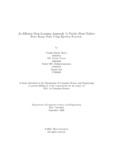| dc.contributor.advisor | Alam, Md. Ashraful | |
| dc.contributor.advisor | Reza, Md Tanzim | |
| dc.contributor.author | Tanvir, Nazmul Karim | |
| dc.contributor.author | Yeasin, MD. Nadim | |
| dc.contributor.author | MD. Mahmuduzzaman, Sarker | |
| dc.contributor.author | Ara, Jannat | |
| dc.date.accessioned | 2023-10-16T05:10:50Z | |
| dc.date.available | 2023-10-16T05:10:50Z | |
| dc.date.copyright | ©2022 | |
| dc.date.issued | 2022-09-28 | |
| dc.identifier.other | ID 18101054 | |
| dc.identifier.other | ID 18101560 | |
| dc.identifier.other | ID 18301073 | |
| dc.identifier.other | ID 17301065 | |
| dc.identifier.uri | http://hdl.handle.net/10361/21837 | |
| dc.description | This thesis is submitted in partial fulfillment of the requirements for the degree of Bachelor of Science in Computer Science, 2022. | en_US |
| dc.description | Cataloged from PDF version of thesis. | |
| dc.description | Includes bibliographical references (pages 29-31). | |
| dc.description.abstract | Heart is the core of human body. A normal heart beats almost 1,15,200 times in a day
and 80 beats per second to make us live alive. But we often take it granted and do
uncertain thinks which stops it to function perfectly. In today’s world cardiovascular
diseases(CVDs) almost kill 17-18 million life’s each year worldwide which makes
it the biggest disease of death. If early detection of heart malfunction or Heart
failure(HF) can be detect millions of people will able to breath even longer than
usual. In our research our main aim is to create an automated Deep Learning based
model which will predict HF and the depth of the condition. Moreover, using which
type of cardiac MRI image slice we can get better result will be consider to be
our main research goal. For this we choose a cardiac MRI dataset which consists
of 1100 different heart patients image having different slices in different pattern.
Furthermore, with more observation and leveling different parameter with the help
of Ejection Fraction(EF) values which depends on systole diastole value of heart we
able to predict the heart failure with an efficient result. AI, ML & deep learning is
the new trend for solving real life human problems. We used different Convolution
Neural Network architecture and obtained accuracy are VGG-16(88.15%), VGG-
19(87.93%), ResNet-50 (75.85%), ResNet-101 (79.53%) Inception-V3 (85.27%). Our
model is being used to find the suitable result to detect the Heart Failure(HF) with
Ejection Fraction(EF). | en_US |
| dc.description.statementofresponsibility | Nazmul Karim Tanvir | |
| dc.description.statementofresponsibility | MD. Nadim Yeasin | |
| dc.description.statementofresponsibility | Sarker MD. Mahmuduzzaman | |
| dc.description.statementofresponsibility | Jannat Ara | |
| dc.format.extent | 41 pages | |
| dc.language.iso | en | en_US |
| dc.publisher | Brac University | en_US |
| dc.rights | Brac University theses are protected by copyright. They may be viewed from this source for any purpose, but reproduction or distribution in any format is prohibited without written permission. | |
| dc.subject | Cardiovascular Disease (CVDs) | en_US |
| dc.subject | Ejection fraction (EF) | en_US |
| dc.subject | CNN | en_US |
| dc.subject | Heart failure (HF) | en_US |
| dc.subject | Vgg-19 | en_US |
| dc.subject | Vgg-16 | en_US |
| dc.subject | Inception-V3 | en_US |
| dc.subject | Cardiac MRI data | en_US |
| dc.subject.lcsh | Health informatics | |
| dc.subject.lcsh | Optical data processing | |
| dc.title | An efficient deep learning approach to predict heart failure from image data using ejection fraction | en_US |
| dc.type | Thesis | en_US |
| dc.contributor.department | Department of Computer Science and Engineering, Brac University | |
| dc.description.degree | B.Sc. in Computer Science | |

